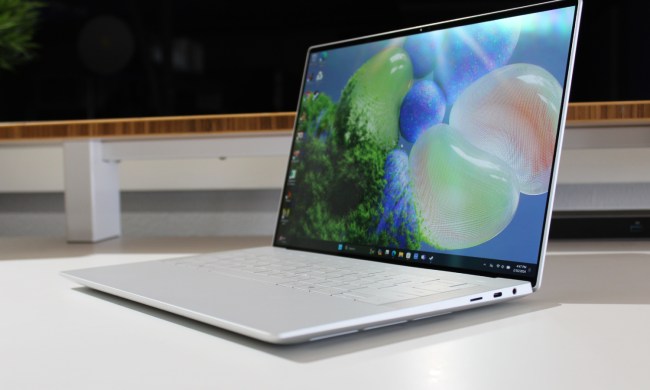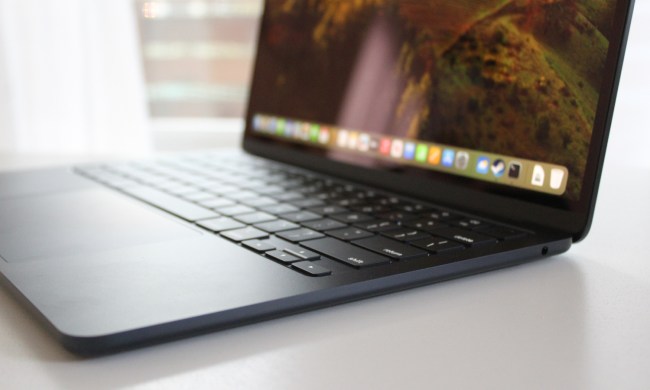
Does the Surface Laptop bring something new to the traditional notebook market, or does Apple’s venerable MacBook Pro 13 manage to teach Microsoft’s latest machine a thing or two? Read on to find out which high-end notebook is worthy of your hard-earned cash.
Specifications compared
|
Surface Laptop |
MacBook Pro 13 (with Touch Bar)  |
|
| Dimensions | 12.13 × 8.79 × 0.57 (in) | 11.97 × 8.36 × 0.59 (in) |
| Weight | 2.76 pounds | 3.02 pounds |
| Processor | 7th-generation Intel Core i5 or i7 | 6th-generation Intel Core i5 or i7 |
| RAM | 4, 8, or 16GB RAM | 8 or 16GB RAM |
| Display | 13.5-inch IPS PixelSense display | 13.3-inch IPS display |
| Resolution | 2,256 × 1,504 | 2,560 × 1,600 |
| Storage | 128GB, 256GB, 512GB SSD, 1TB (coming) | 256GB, 512GB, 1TB SSD |
| Touch | 10-point touchscreen | Touch Bar |
| Ports | USB Type-A 3.0, mini-DisplayPort, SurfaceConnect, 3.5mm headset | 4 x USB-C (Thunderbolt 3), any can charge; 3.5mm headset |
| Webcam | 720p HD with infrared camera for Windows Hello support | 720p FaceTime HD |
| Operating System | Windows 10 S (upgradable to Windows 10 Pro) | MacOS Sierra |
| Battery | TBA | 49.2-watt-hour battery |
| Price | $999+ | $1,799+ |
| Review | Hands-on impressions | 3 out of 5 stars |
Tried-and-true design takes on something new
When Apple updated the MacBook Pro line in late 2016, it opted for the same aluminum chassis and reiterated the same elegant, understated design that has adorned its lineup for a few generations. The new MacBook Pro looks a lot like the old MacBook Pro, with a chassis that’s considerably thinner and a display that’s framed by smaller bezels. As always, the MacBook Pro looks good in just about any environment, and Apple had no good reason to change things all that much.

Microsoft was designing something new, however, and it went in the opposite direction in creating the Surface Laptop design. First, the Surface Laptop utilizes a wedge shape that tapers from really thin at the rear to even thinner at the front. The hinge is also hidden to keep things streamlined, and the use of the same Alcantara fabric that covers some other Microsoft Surface keyboards both maintains the brand’s familiarity and promises a soft-touch feel when typing.

In addition, Microsoft is offering the Surface Laptop in four colors — platinum, burgundy, cobalt, and gold. The machine is made of machined aluminum, which is a departure from the magnesium alloy that Microsoft used to fashion its other Surface products.
It’s hard to fault either design. Both machines are thin, light, comfortable to hold, and crafted with some serious attention to detail. We think Microsoft has offered enough personality, though, that it deserves some credit — the Surface Laptop is a unique design that manages to stand out without putting off, and that’s a fine line to walk.
Winner: Surface Laptop
Both are easy enough to carry around, and should last a while
The Pro 13 is a light machine at just over three pounds, and it’s also quite thin at 0.59-inches thick. Like many modern notebooks, the overall chassis size was minimized thanks to the thin bezel that frames the display. Needless to say, it’s a comfortable machine to carry around.

At the same time, Apple decreased the battery capacity with the revised Pro line in its quest to decrease thickness. The Touch Bar version has the smallest battery in the current Pro lineup (49.2 watt-hours), but it still managed to squeeze out 10 hours and 17 minutes in our battery tests.
As previously mentioned, the Surface Laptop is a wedge, starting at 0.57-inches thick at the rear and tapering to 0.39-inches thick at the front. It’s very light at 2.76 pounds. Because its display uses Microsoft’s unusual, 3:2 aspect ratio, the Surface Laptop’s dimensions are a litter wider and taller than those of the MacBook Pro.

Microsoft promises 14.5 hours of battery life on the Surface Laptop, though the company has yet to publish the device’s official battery capacity. Given that Microsoft’s video testing showed the Pro as offering around the same 10 hours as our own test, we’re comfortable assuming that we can trust its Surface Laptop estimates.
Going by these numbers, the Surface Laptop promises superior battery life, at least while watching video. It’s also thinner and lighter than the Pro, though it is a bit wider and taller. In terms of portability, then, Microsoft’s first notebook is the preferable machine to carry around.
Winner: Surface Laptop
The pen (and touchscreen) is mightier than the Touch Bar
Apple focused its user interface innovation on the Pro’s keyboard, eschewing a full touchscreen in favor of an OLED strip that runs along the top of the keyboard where the physical function keys used to be. Called the Touch Bar, this new feature has generated some support among developers, and has gone on to become a useful addition in a variety of circumstances (despite our personal reservations).
The MacBook Pro also sports a massive touchpad that utilizes the company’s faux-click Force Touch technology. Some people love it, some not so much. At the same time, making the machine so thin meant squeezing in the second-gen of Apple’s butterfly keyboard, which has extremely shallow key travel and a very specific feel. Again, some people love it, and some hate it.

The Surface Laptop, of course, utilizes Microsoft’s well-conceived touchscreen technology with 10-point multitouch support. It also offers full support for the Surface Pen, and for the innovative Surface Dial that Microsoft debuted alongside the Surface Studio last year. Apple’s Touch Bar is nice, but a touchscreen display, active pen, and the Surface Dial allow for more power and flexibility. Note, though, that the Pen and Dial are not standard.

In terms of the keyboard, Microsoft utilized a variant of the mechanism used in its various Type Cover keyboards, which offers 1.5-millimeter travel, and a mechanism that Microsoft promises is comfortable for long-term use. According to early impressions, the Surface Laptop’s keyboard is also somewhat hit or miss depending on the user, but it’s likely nowhere as polarizing as Apple’s newest keyboard. The decently-sized touchpad with Precision Touchpad support seems more conventionally useful, and that might be a net benefit in this case.
Winner: Surface Laptop
Only the slightest performance advantage (on paper)
The Pro 13 is built around sixth-gen Intel Core processors, and relies exclusively on Intel Iris integrated graphics. RAM can be bumped up to 16GB, and up to a 2TB PCIe SSD can be configured.
The Surface Laptop, on the other hand, utilizes seventh-gen Intel Core processors, and offers a choice between standard Intel HD graphics and the slightly improved integrated Intel Iris Plus GPU. Up to 16GB of RAM and up to 512GB PCIe SSD can be selected, though a 1TB model will be available down the line.
In other words, both machines are powered by very similar components. We haven’t yet run benchmarks on the Surface Laptop, but Intel’s seventh-gen Core processors offer a 15-percent performance improvement out of the box. For this reason alone, it’s likely that loading up with newer components gives the Surface Laptop a slight advantage.
Winner: Surface Laptop
When it comes to connectivity, the future outweighs the past
Apple drew some criticism for dropping any semblance of legacy support and equipping its new MacBook Pro machines with only the new USB Type-C connection. The Pro 13 with Touch Bar includes four of these futuristic ports with full Thunderbolt 3 support, meaning that although you’ll need dongles to connect your legacy devices, you’ll still be able to connect quite a few of them.

Microsoft went in a different and, dare we say, somewhat archaic direction with the Surface Laptop. It’s not only lacking in connectivity, with only three total inputs, but they’re decidedly old-school. There’s a single USB Type-A port, a DisplayPort, and Microsoft’s proprietary Surface port for charging or connecting a dock.
While the use of USB Type-A provides some legacy support, it’s only one port, and it’s slower than USB Type-C / Thunderbolt 3. The DisplayPort is nice, but if you want to connect via HDMI, then you’ll need an adapter anyways.

Both machines offer modern Wi-Fi and Bluetooth connectivity, along with 3.5-millimeter headphone jacks. Those are pretty standard fare today, however.
We prefer to see a mix of legacy and future support in terms of connectivity, and so we’ve dinged the newest Pro in comparison to machines such as HP’s Spectre x360 15, which manages both USB Type-A and USB Type-C connectivity. However, we have to give Apple the nod in this particular case.
The Surface Laptop is almost comically under-equipped in terms of connectivity, and it’s hard to imagine why Microsoft wouldn’t equip even a single USB Type-C port. We just don’t understand Microsoft’s decision here.
Winner: MacBook Pro 13
Two excellent screens, no real advantage
Apple equipped the Pro 13 with what’s widely characterized as one of the best displays you can buy in a notebook today. It’s extremely bright, with excellent color quality, accuracy, and strong contrast. It’s a 13.3-inch display with 2,560 x 1,600-pixel resolution and 227 pixels per inch.

The display on the Surface Laptop still needs to undergo independent testing, but if Microsoft’s other Surface displays are any indication, then this one is likely to be excellent as well. It’s a 13.5-inch display that uses Microsoft’s PixelSense technology for accurate touch and pen input, and it runs at 2,256 x 1,504-pixel resolution, or 201 pixels per inch. Because it utilizes the usual Surface 3:2 aspect ratio that’s a bit taller and squarish than most widescreen displays, it’s great for productivity. Nonetheless, it does have some letter boxing when watching video.

Both machines offer excellent displays, although we’ll need to wait for final colorimeter testing to see just how good the Surface Laptop panel really looks. It’s hard to call a winner here because, while the Surface Laptop offers a slightly larger display, it’s also a bit less sharp. We’re going to go ahead and call this one a tie, and say that regardless of which of these machines you pick up, you’re going to love the display quality.
Winner: Tie
Price and Availability
Simply stated, the Pro 13 is an expensive machine. The Touch Bar version starts at $1,799, and comes with a 2.9GHz Core i5 processor, 8GB of RAM, a 256GB SSD. This goes all the way up to $2,899, which nets you a 3.3GHz Intel Core i7 processor, 16GB of RAM, and a 1TB SSD. Needless to say, that’s one expensive notebook.
Microsoft, however, priced the Surface Laptop to be marginally more competitive at the low end and then ramping up from there. With an Intel Core i5-7200U processor, 4GB of RAM, and 128GB SSD, the Surface Laptop costs $999. The current high-end machine is configured with an Intel Core i7-7500U processor, 16GB of RAM, and 512GB SSD, and costs $2,199.
That means that when similarly equipped with a Core i7 processor, 16GB of RAM, and 512GB SSD, the Pro 13 is $2,499 whereas the Surface Laptop runs $2,199. Microsoft priced its new notebook at the high end, but Apple still carves out a special place for itself.
The Surface Laptop will ship in June, whereas the Pro 13 is available today. Nevertheless, Microsoft maintains a small advantage in pricing, which is faint praise given the generally stratospheric pricing strategies that both companies have employed.
It’s worth noting that the Surface Laptop ships with Windows 10 S installed, which along with some other limitations, means you won’t be able to install applications from outside of the Windows Store. From now until December 31, Surface Laptop owners can upgrade to Windows 10 Pro for free, and after that, it will cost $49. That’s not enough to sway our decision, but we find it an interesting decision on Microsoft’s part.
Winner: Surface Laptop
Conclusion
Both the MacBook Pro 13 with Touch Bar and the Surface Laptop represent their respective company’s best effort at producing the perfect notebook. They’re both thin and lightweight machines with superior designs and build quality, and they both enjoy an attention to detail that’s otherwise unmatched in the PC industry.
At the same time, they represent different philosophies. Microsoft went with a modern, fresh, and somewhat unusual approach, particularly in regards to the keyboard. Apple, on the other hand, took something that’s tried-and-true and made it thinner, while still managing to stock it with the company’s most up-to-date technology. Which approach is better comes down to personal preference, and to one’s tolerance for standing out in the crowd.
In the final analysis, both the MacBook Pro and the Surface Laptop are excellent machines that also command high-end prices. Regardless of which you select, you’re going to spend a pretty penny. We might change our opinion once we’ve had a chance to review the Surface Laptop in full, but for now, we give the overall win to the newest addition to the Surface lineup.
Winner: Surface Laptop



